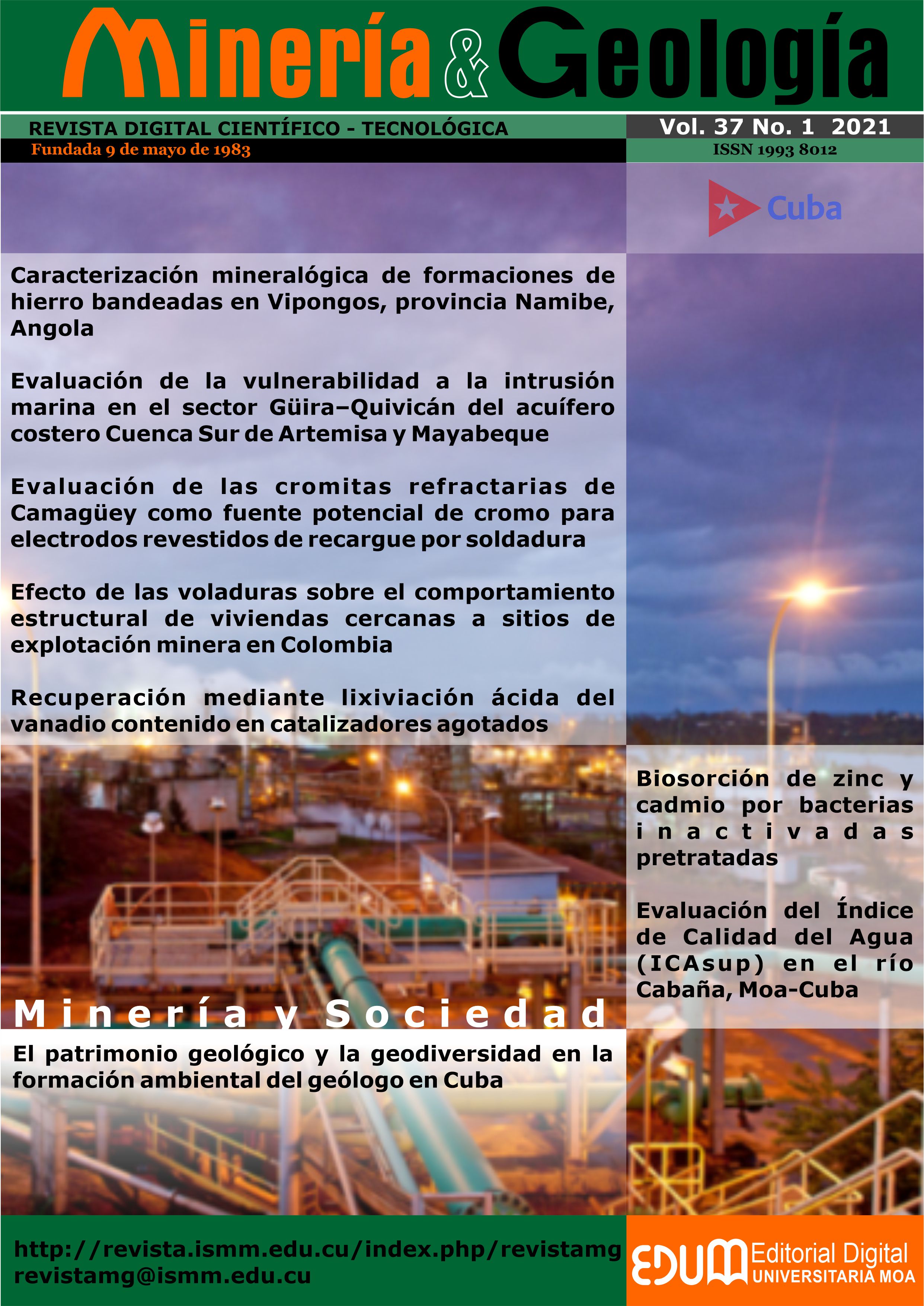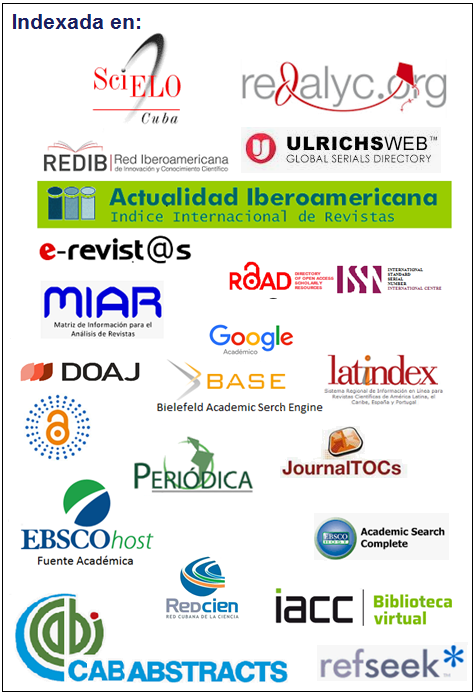Evaluation of Water Quality Index in Cabaña River, Moa-Cuba
Keywords:
water quality, superficial water, pollution of river courses, residual pollutants, Cabaña River, physical-chemical parameters.Abstract
Quality of surface waters is generally affected by discharges of domestic and industrial waste that alter their physical, chemical and bacteriological properties, rendering them unfit for consumption. The purpose of this study is to evaluate the water quality of Cabaña River (Moa, Holguín) by applying the surface water quality index proposed by Montoya. For analyzing the physical-chemical and bacteriological compositions of water, 20 sampling sites were selected in 2017-2018 stage in two moments: rainy and dry seasons. A water quality index was calculated for each site and sampling date. It was found evaluated indicators exceed the values established by national and international standards and the water quality decreases as the river travels the path of its channel from the upper zone to the lower zone of the sub-basin. Results show that quality of water decreases in the same sense that river travels its path from the upper zone to the lower zone of the sub-basin. It was determined that a large part of the river's pollutant load comes from industrial and domestic waste and sewer discharges, which cause a decrease in the river's self-purification capacity due to their magnitude.Downloads
References
APHA AWWA WEF. 2012: Standard Methods for the Examination of Water and Wastewater. 22st Ed. Washington: American Public Health Association. Consultado: 2015/05/02. Disponible en: https://www.standardmethods.org/.
Bicera, C. 2014: Evaluación de la calidad de las aguas del río Cayo Guam e impacto ambiental en el municipio Moa. Fernández Rodríguez, M. (tutor). Tesis de Maestría. Universidad de Moa, Cuba. http://repositorio.ismm.edu.cu./Cristian pdf.
Cayax, M. Á. M. 2017: Uso de la tierra y calidad del agua superficial en la cuenca periurbana rio Platanitos, Guatemala. Revista Ingeniería Agrícola, 4(4): 19-23.
Chiliquinga-Quinapanta, C. A. y Donoso-Cruz, H. E. 2012: Caracterización de la calidad de agua de la microcuenca del río Pachanlica de la provincia de Tungurahua tomando como base la metodología ICA de Montoya. S.l.: Escuela Superior Politécnica de Chimborazo.
Fernández-Rodríguez, M. 2016: Vulnerabilidad a la contaminación de las aguas del río Cabaña en la zona minera de Moa. Cuba. En: II Simposio Internacional del Agua en Áreas Protegidas. Topes de Collantes, Cuba.
Fernández-Rodríguez, M.; Nfundiko-Christian, B.; Guardado-Lacaba, R. y Almaguer-Carmenate, Y. 2018: Evaluación hidroquímica de las aguas del río Cayo Guam, Moa, Cuba. Minería y Geología, 34(3): 268–288.
Flores, J. 2013: Propuesta de índice de calidad de agua residual utilizando un modelo aritmético ponderado. Interciencia, 38(2): 145-149.
García-Fernández, J. M. y Gutiérrez-Díaz, J. B. 2015: Un índice para evaluar la calidad de los recursos hídricos superficiales en cuencas hidrográficas (ICAsp 2014). Voluntad Hidráulica, 113. ISSN 0505-9461.
Kurissery, S.; Kanavillil, N.; Verenitchb, S. y Mazumderb, A. 2012: Caffeine as an anthropogenic marker of domestic waste: A study from Lake Simcoe watershed. Ecol. Indic., 23: 501–508.
Lekshmiprasad, S. y Mophin, K. 2017. Water Quality Assessment of Ashtamudi Lake Using Nsfwqi. International Journal of Emerging Technology and Advanced Engineering, 7(1). Disponible en: http://www.ijetae.com
Montoya, H.; Contreras, C. y García, V. 1997: Estudio Integral de la Calidad del Agua en el estado de Jalisco. Guadalajara. Comisión Nacional del Agua. p. 106.
Norma Cubana 1021: 2014: Higiene Comunal en fuentes de abastecimiento de agua. Calidad y protección sanitaria. La Habana: Oficina Nacional de Normalización.
Norma Cubana 827: 2017: Agua potable, requisitos sanitarios. La Habana: Oficina Nacional de Normalización.
Li, S.; Xu, Z.; Wang, H.; Wang, J. y Zhang, Q. 2009: Geochemistry of the upper Han River basin, China. 3: Antropogenic inputs and chemical weathering to the dissolved load. Chem. Geol., 264: 89-95.
Organización Mundial de la Salud (OMS). 2017: Guias para la calidad del agua de consumo humano. 4ta ed. 564 p. ISBN: 978-92-4-354995-8.
Pedraza, E. 2016: Variables más influyentes en la calidad del agua del río Bogotá mediante análisis de datos. Logos, Ciencia & Tecnología, 7(2): 35-43.
Rodríguez-Pacheco, R. L. 2002: Estudio experimental de flujo y transporte de cromo, níquel y manganeso en residuos de la zona minera de Moa (Cuba): influencia del comportamiento hidromecánico. Candela-Lledó, L. y Lloret-Morancho, A. (tutores). Tesis doctoral. Instituto Geológico y Minero de España. https://10.13140/2.1.3934.7849.
Samboni, R.; Carvajal, E. y Escobar, J. C. 2017: Revisión de parámetros fisicoquímicos como indicadores de calidad y contaminación del agua. Revista Ingeniería e Investigación, 27(3): 172-181. Consultado: 2018/06/23. Disponible en: http://www.scielo.org.co/pdf/iei/v27n3/v27n3a19.pdf.
Terrero-Abella. A. 1995: Evaluación de la calidad de las aguas superficiales y subterráneas en la cuenca del río Moa, Cuba, por efecto de la actividad minero metalúrgica. p. 143-146. En: Aspectos geológicos de protección ambiental. Volumen II. Uruguay: Oficina Regional de Ciencia y Tecnología de la UNESCO para América Latina y el Caribe.
Thi, M. 2011: Development of Water Quality Indexes to Identify Pollutants in Vietnam’s Surface Water. Journal of Environmental Engineering, 137(4): 273-283. https://doi:10.1061/(ASCE)EE.1943-7870.0000314.
Torres, B.; González, G.; Rustrián, E. y Houbron, E. 2013: Enfoque de cuenca para la identificación de fuentes de contaminación y evaluación de la calidad de un río, Veracruz, México. Rev. Int. Contam. Ambie., 29: 135-146.
Rodríguez-Miranda, J. P.; Serna-Mosquera, J. A. y Sánchez-Céspedes, J. M. 2016: Índices de calidad en cuerpos de agua superficiales en la planificación de los recursos hídricos. Logos, Ciencia & Tecnología, 8(1): 159-167.
Valcárcel, L.; Alberro, N. y Frías, D. 2009: El Índice de calidad de agua como herramienta para la gestión de los recursos hídricos. Medio Ambiente y Desarrollo, 9(16): 1–5.
Published
How to Cite
Issue
Section
- Authors retain copyright and guaranteeing the right magazine to be the first publication of the work as licensed under a Creative Commons Attribution-NonCommercial that allows others to share the work with an acknowledgment of the work's authorship and initial publication in this journal.
- Authors may establish separate supplemental agreements for the exclusive distribution version of the work published in the journal (eg, place it in an institutional repository or publish it in a book), with an acknowledgment of its initial publication in this journal.
- Authors are allowed and recommended to disseminate their work through the Internet (e.g., in institutional telematic archives or on their websites) before and during the submission process, which can produce interesting exchanges and increase citations of the published work. (See The effect of open access)




